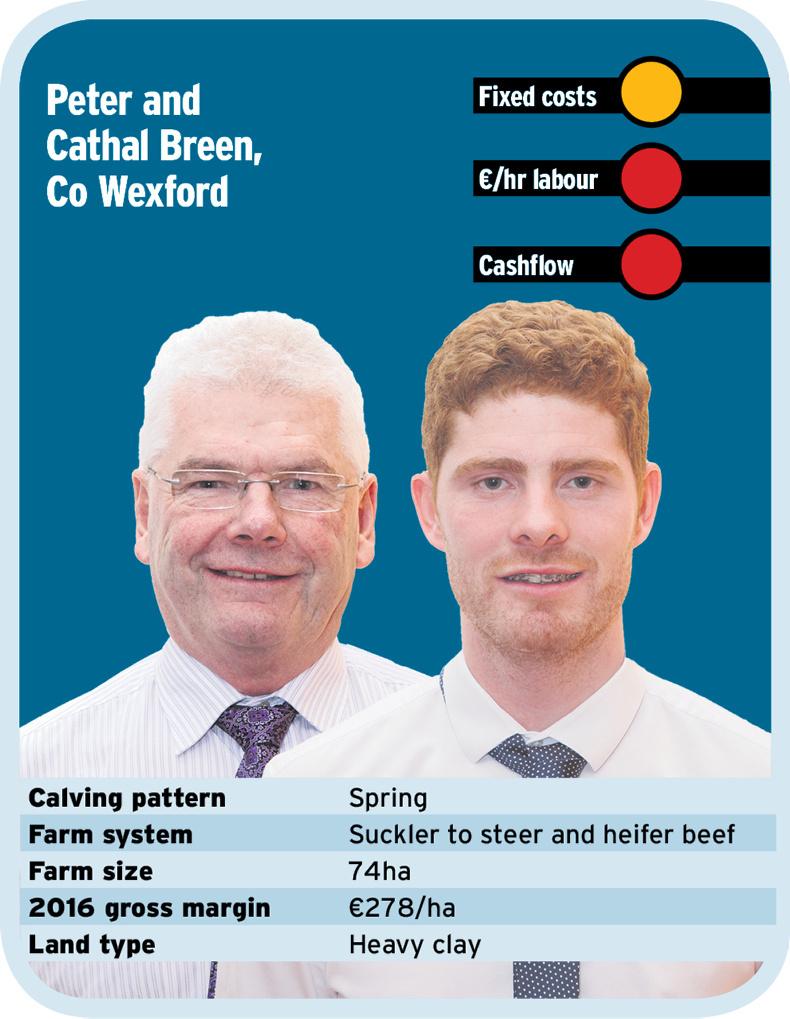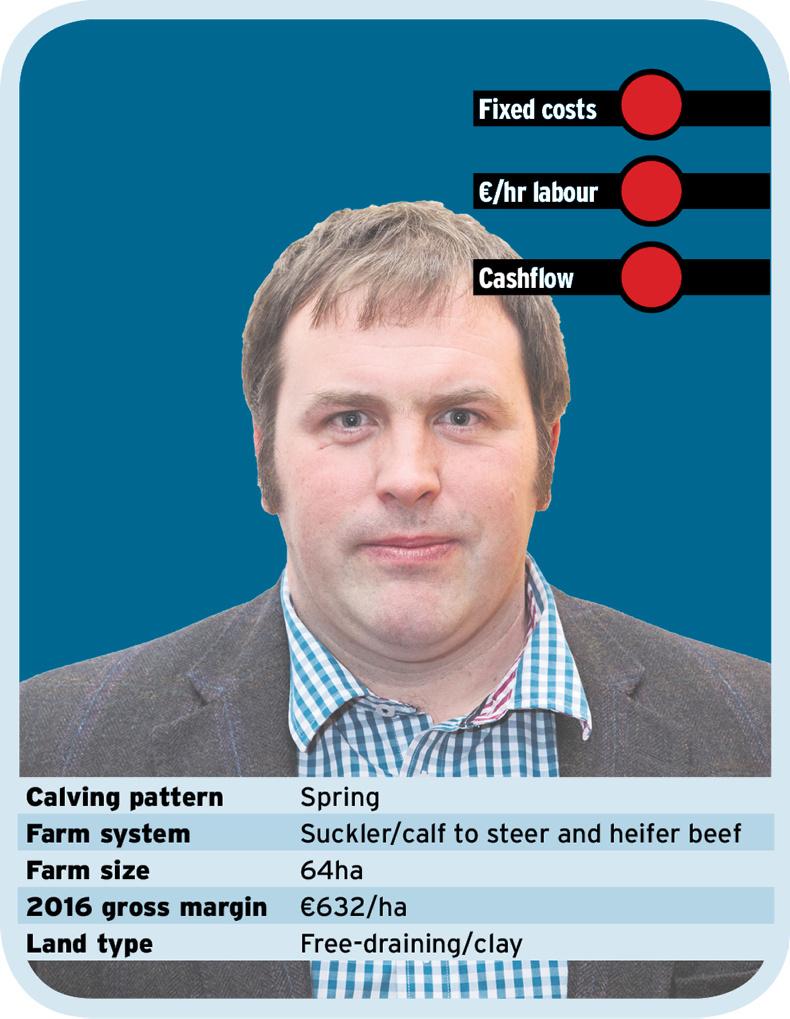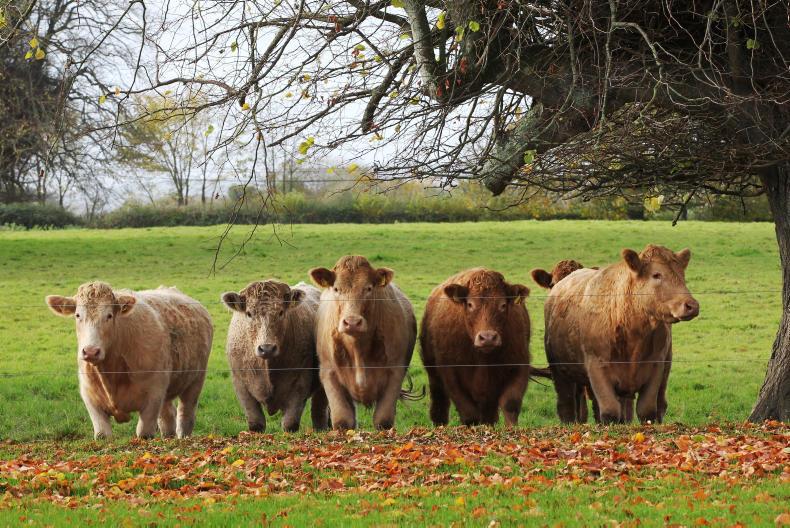Of the 27 new programme participants, seven produced steer beef in 2016. There is a big range of land types, breeds and farmer circumstances, but a common attitude of enthusiasm. The collector card-style layout shown here will be a common feature of the new programme, and allow for a focus on the farm’s fixed costs, labour demand and cashflow situation. These three statistics will be presented in a traffic-light system.
For fixed costs, less than €350/ha will be allocated a green light, €350-550/ha will be classified orange, with red lights for figures beyond this. Fixed costs are subtracted from gross margin to leave a net profit figure (excluding supports/subsidies).
The €/hr labour figure is taken as net profit/hours worked per year. When the programme is finished, the farmer’s final figure will be compared with this 2016 figure. Red, orange and green lights indicate <€5, €5-€12.50 and >€12.50 net earnings per hour worked respectively. Also, during the programme a number of farmers will take part in a labour challenge whereby their labour inputs are scrutinised further.
On cashflow, a farm with no sales for seven or more consecutive months in a year will be allocated a red light, with orange for five or more and green where a farm has less than five months in a row without any sales in a given year.
Steer producers’ farm performance
At less than 1.8 LU/ha, initial stocking rates on our steer beef farms are relatively low. Average gross margin on the seven farms is a modest €570/ha. There is huge potential to push both of these figures. Those with big fixed costs need to achieve high gross margins to cover these and leave a margin for themselves. Gain from grass drives margins in steer beef – the focus must be on pushing numbers on grassland, extending the grazing seasons and making top-quality silage.
Harry Lalor was hit by an outbreak of leptospirosis in 2016 and was forced to cull a lot of cows, his output volume was high but its value low. He is also creeping toward bull-finisher levels in terms of spending on feed. Focusing on herd health and grassland will turn things around no doubt. Ken Gill’s performance is impressive given his organic status and it will be interesting to see how he can push his holding.
In 2016 he led the way in terms of earnings per hour at just under €10, but has he reached a peak? There is big scope for Ricky Milligan to reach eye-watering levels of output given his dry farm and expanding calf-to-beef enterprise – definitely one to watch. The Stanleys face a significant task in supporting three full-time labour units from their farm, but the drive among them is evident and the farm itself is set up well to do so. Martin Downes might have the healthiest gross margin in the programme starting off, but his fixed costs are high, dragging down his net margin.

Cathal and Peter Breen, Killena, Co Wexford
Cathal and his father Peter are farming near Gorey. The land is quite heavy, with some of the wettest areas in forestry. They currently run a herd of 51 suckler cows, aiming to finish the heifers at 21-22 months and the steers at 23-24 months. Cathal came home from Australia in June 2015 with the desire to get involved in the running of the farm. He formed a farm partnership with Peter in April of last year. Peter is currently farming full-time, while Cathal is farming part-time. The plan is for Cathal to take the reins from his father in the coming years.

Brian Doran, Carnew,
Co Wicklow
Brian is farming in Carnew, Co Wicklow. The land is well-drained and laid out in three blocks. Brian runs 45 mixed-breed suckler cows with a high-index Limousin stock bull. All progeny are finished along with other bought-in cattle. Bullocks are slaughtered at 24 months and heifers at 18-20 months. Replacements are generally purchased as in-calf heifers or with calves at foot. He is married to Deirdre and they have two young daughters. Brian also fits a small timber business and some haulage work around his farming.

Martin Downes, Multyfarnham,
Co Westmeath
Martin farms full-time on relatively heavy ground in Multyfarnham, Co Westmeath. The farm is laid out in two blocks, 67ha around the yard and the balance three miles away. He has 105 suckler cows, with all progeny brought through to slaughter. Replacements are homebred. Predominant cow type is a Limousin x Angus, bred to Simmental and Charolais bulls. He also maintains a flock of 160 Suffolk-cross ewes, which are mixed-grazed with cattle. Martin is married to Elizabeth and they have three children. Martin joins the programme with the highest gross margin of the 27 participants.

Ken Gill, Clonbullogue,
Co Offaly
Ken is farming full-time at Clonbullogue Co Offaly. This is the first and only organic farm to have joined the BETTER Farm programme, with Ken’s farm obtaining full organic status in May 2015. The farm consists of 72ha in grass, 17ha in red clover and 6ha being sown for winter forage crops typically a kale, rape and turnip mix. There is some forestry and willow planted on the poorer land. Up to 70 cows are calved in the autumn, with progeny being brought through to finish.

Harry Lalor, Ballacolla,
Co Laois
Harry is farming full-time in conjunction with his father Joe in Ballacolla, Co Laois. The land is laid out in one block and soil type varies from free-draining to heavy, peaty gley. He currently runs 110 spring-calving cows and operates a suckler-to-beef system. Herd health has been an issue in recent years and Harry will look to making big improvements in this area with the help of the programme team. He also has a mid-season lambing flock.

Ricky Milligan,
Robertstown, Co Kildare
Ricky Milligan farms in partnership with his father Henry. The farm is laid out in two parcels. The 24ha home farm is all in grass while the remaining 40ha are two miles away and partially in tillage. Ricky runs a 40 cow spring-calving herd and operates a suckler-to-beef system with a mixture of AI and Hereford stock bulls being used. A calf-to-beef system is also being developed whereby Hereford cross calves are sourced from dairy herds from February to April and reared on farm.

Gilbert, Dwayne and Raymond Stanley,
Thurles, Co Tipperary
Raymond, Gilbert and Dwayne Stanley farm near Thurles in Co Tipperary. They currently run 100 suckler cows, split into spring- and autumn-calving herds. Progeny are finished in a suckler-to-steer beef system. Soil type is generally free draining with a small percentage of the farm liable to flooding. Investment in recent years included the construction of a new slatted shed.

Read more
Saudi beef extension small step forward
Quality bullocks up by €10 to €20 per head at Balla Mart
Of the 27 new programme participants, seven produced steer beef in 2016. There is a big range of land types, breeds and farmer circumstances, but a common attitude of enthusiasm. The collector card-style layout shown here will be a common feature of the new programme, and allow for a focus on the farm’s fixed costs, labour demand and cashflow situation. These three statistics will be presented in a traffic-light system.
For fixed costs, less than €350/ha will be allocated a green light, €350-550/ha will be classified orange, with red lights for figures beyond this. Fixed costs are subtracted from gross margin to leave a net profit figure (excluding supports/subsidies).
The €/hr labour figure is taken as net profit/hours worked per year. When the programme is finished, the farmer’s final figure will be compared with this 2016 figure. Red, orange and green lights indicate <€5, €5-€12.50 and >€12.50 net earnings per hour worked respectively. Also, during the programme a number of farmers will take part in a labour challenge whereby their labour inputs are scrutinised further.
On cashflow, a farm with no sales for seven or more consecutive months in a year will be allocated a red light, with orange for five or more and green where a farm has less than five months in a row without any sales in a given year.
Steer producers’ farm performance
At less than 1.8 LU/ha, initial stocking rates on our steer beef farms are relatively low. Average gross margin on the seven farms is a modest €570/ha. There is huge potential to push both of these figures. Those with big fixed costs need to achieve high gross margins to cover these and leave a margin for themselves. Gain from grass drives margins in steer beef – the focus must be on pushing numbers on grassland, extending the grazing seasons and making top-quality silage.
Harry Lalor was hit by an outbreak of leptospirosis in 2016 and was forced to cull a lot of cows, his output volume was high but its value low. He is also creeping toward bull-finisher levels in terms of spending on feed. Focusing on herd health and grassland will turn things around no doubt. Ken Gill’s performance is impressive given his organic status and it will be interesting to see how he can push his holding.
In 2016 he led the way in terms of earnings per hour at just under €10, but has he reached a peak? There is big scope for Ricky Milligan to reach eye-watering levels of output given his dry farm and expanding calf-to-beef enterprise – definitely one to watch. The Stanleys face a significant task in supporting three full-time labour units from their farm, but the drive among them is evident and the farm itself is set up well to do so. Martin Downes might have the healthiest gross margin in the programme starting off, but his fixed costs are high, dragging down his net margin.

Cathal and Peter Breen, Killena, Co Wexford
Cathal and his father Peter are farming near Gorey. The land is quite heavy, with some of the wettest areas in forestry. They currently run a herd of 51 suckler cows, aiming to finish the heifers at 21-22 months and the steers at 23-24 months. Cathal came home from Australia in June 2015 with the desire to get involved in the running of the farm. He formed a farm partnership with Peter in April of last year. Peter is currently farming full-time, while Cathal is farming part-time. The plan is for Cathal to take the reins from his father in the coming years.

Brian Doran, Carnew,
Co Wicklow
Brian is farming in Carnew, Co Wicklow. The land is well-drained and laid out in three blocks. Brian runs 45 mixed-breed suckler cows with a high-index Limousin stock bull. All progeny are finished along with other bought-in cattle. Bullocks are slaughtered at 24 months and heifers at 18-20 months. Replacements are generally purchased as in-calf heifers or with calves at foot. He is married to Deirdre and they have two young daughters. Brian also fits a small timber business and some haulage work around his farming.

Martin Downes, Multyfarnham,
Co Westmeath
Martin farms full-time on relatively heavy ground in Multyfarnham, Co Westmeath. The farm is laid out in two blocks, 67ha around the yard and the balance three miles away. He has 105 suckler cows, with all progeny brought through to slaughter. Replacements are homebred. Predominant cow type is a Limousin x Angus, bred to Simmental and Charolais bulls. He also maintains a flock of 160 Suffolk-cross ewes, which are mixed-grazed with cattle. Martin is married to Elizabeth and they have three children. Martin joins the programme with the highest gross margin of the 27 participants.

Ken Gill, Clonbullogue,
Co Offaly
Ken is farming full-time at Clonbullogue Co Offaly. This is the first and only organic farm to have joined the BETTER Farm programme, with Ken’s farm obtaining full organic status in May 2015. The farm consists of 72ha in grass, 17ha in red clover and 6ha being sown for winter forage crops typically a kale, rape and turnip mix. There is some forestry and willow planted on the poorer land. Up to 70 cows are calved in the autumn, with progeny being brought through to finish.

Harry Lalor, Ballacolla,
Co Laois
Harry is farming full-time in conjunction with his father Joe in Ballacolla, Co Laois. The land is laid out in one block and soil type varies from free-draining to heavy, peaty gley. He currently runs 110 spring-calving cows and operates a suckler-to-beef system. Herd health has been an issue in recent years and Harry will look to making big improvements in this area with the help of the programme team. He also has a mid-season lambing flock.

Ricky Milligan,
Robertstown, Co Kildare
Ricky Milligan farms in partnership with his father Henry. The farm is laid out in two parcels. The 24ha home farm is all in grass while the remaining 40ha are two miles away and partially in tillage. Ricky runs a 40 cow spring-calving herd and operates a suckler-to-beef system with a mixture of AI and Hereford stock bulls being used. A calf-to-beef system is also being developed whereby Hereford cross calves are sourced from dairy herds from February to April and reared on farm.

Gilbert, Dwayne and Raymond Stanley,
Thurles, Co Tipperary
Raymond, Gilbert and Dwayne Stanley farm near Thurles in Co Tipperary. They currently run 100 suckler cows, split into spring- and autumn-calving herds. Progeny are finished in a suckler-to-steer beef system. Soil type is generally free draining with a small percentage of the farm liable to flooding. Investment in recent years included the construction of a new slatted shed.

Read more
Saudi beef extension small step forward
Quality bullocks up by €10 to €20 per head at Balla Mart














 This is a subscriber-only article
This is a subscriber-only article













SHARING OPTIONS: